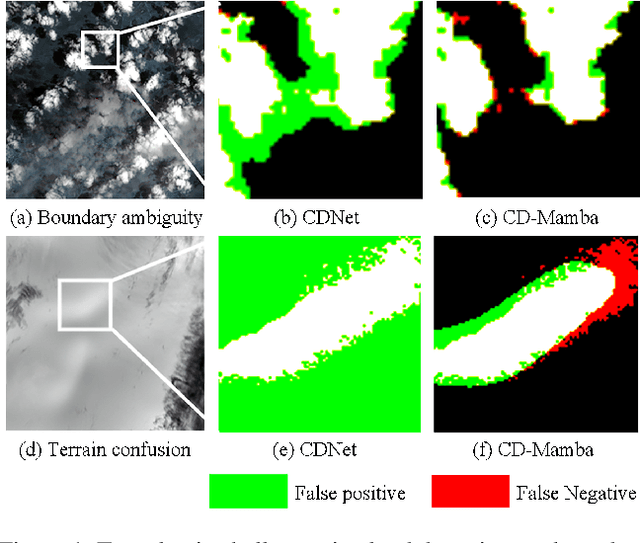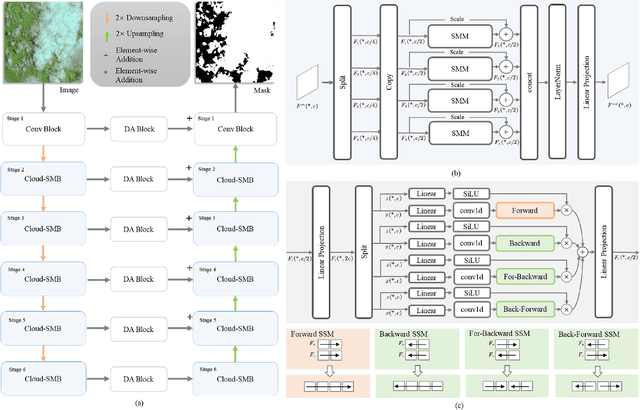Changlu Chen
CD-Mamba: Cloud detection with long-range spatial dependency modeling
Sep 05, 2025



Abstract:Remote sensing images are frequently obscured by cloud cover, posing significant challenges to data integrity and reliability. Effective cloud detection requires addressing both short-range spatial redundancies and long-range atmospheric similarities among cloud patches. Convolutional neural networks are effective at capturing local spatial dependencies, while Mamba has strong capabilities in modeling long-range dependencies. To fully leverage both local spatial relations and long-range dependencies, we propose CD-Mamba, a hybrid model that integrates convolution and Mamba's state-space modeling into a unified cloud detection network. CD-Mamba is designed to comprehensively capture pixelwise textural details and long term patchwise dependencies for cloud detection. This design enables CD-Mamba to manage both pixel-wise interactions and extensive patch-wise dependencies simultaneously, improving detection accuracy across diverse spatial scales. Extensive experiments validate the effectiveness of CD-Mamba and demonstrate its superior performance over existing methods.
Zero-shot Generalist Graph Anomaly Detection with Unified Neighborhood Prompts
Oct 18, 2024



Abstract:Graph anomaly detection (GAD), which aims to identify nodes in a graph that significantly deviate from normal patterns, plays a crucial role in broad application domains. Existing GAD methods, whether supervised or unsupervised, are one-model-for-one-dataset approaches, i.e., training a separate model for each graph dataset. This limits their applicability in real-world scenarios where training on the target graph data is not possible due to issues like data privacy. To overcome this limitation, we propose a novel zero-shot generalist GAD approach UNPrompt that trains a one-for-all detection model, requiring the training of one GAD model on a single graph dataset and then effectively generalizing to detect anomalies in other graph datasets without any retraining or fine-tuning. The key insight in UNPrompt is that i) the predictability of latent node attributes can serve as a generalized anomaly measure and ii) highly generalized normal and abnormal graph patterns can be learned via latent node attribute prediction in a properly normalized node attribute space. UNPrompt achieves generalist GAD through two main modules: one module aligns the dimensionality and semantics of node attributes across different graphs via coordinate-wise normalization in a projected space, while another module learns generalized neighborhood prompts that support the use of latent node attribute predictability as an anomaly score across different datasets. Extensive experiments on real-world GAD datasets show that UNPrompt significantly outperforms diverse competing methods under the generalist GAD setting, and it also has strong superiority under the one-model-for-one-dataset setting.
Generative approach to unsupervised deep local learning
Jun 28, 2019Abstract:Most existing feature learning methods optimize inflexible handcrafted features and the affinity matrix is constructed by shallow linear embedding methods. Different from these conventional methods, we pretrain a generative neural network by stacking convolutional autoencoders to learn the latent data representation and then construct an affinity graph with them as a prior. Based on the pretrained model and the constructed graph, we add a self-expressive layer to complete the generative model and then fine-tune it with a new loss function, including the reconstruction loss and a deliberately defined locality-preserving loss. The locality-preserving loss designed by the constructed affinity graph serves as prior to preserve the local structure during the fine-tuning stage, which in turn improves the quality of feature representation effectively. Furthermore, the self-expressive layer between the encoder and decoder is based on the assumption that each latent feature is a linear combination of other latent features, so the weighted combination coefficients of the self-expressive layer are used to construct a new refined affinity graph for representing the data structure. We conduct experiments on four datasets to demonstrate the superiority of the representation ability of our proposed model over the state-of-the-art methods.
 Add to Chrome
Add to Chrome Add to Firefox
Add to Firefox Add to Edge
Add to Edge